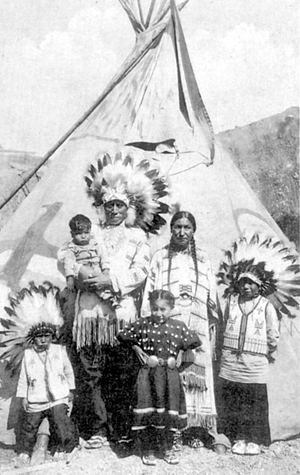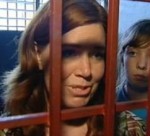Documentary Tracks Cultural Genocide of American Indians
New documentary tracks cultural genocide of American Indians
By Rose Aguilar
Truthout
In 1892, US Army officer Richard Pratt delivered a speech in which he described his philosophy behind US government-run boarding schools for American Indians.
“A great general has said that the only good Indian is a dead one,” he said.
“In a sense, I agree with the sentiment, but only in this: that all the Indian there is in the race should be dead. Kill the Indian in him, and save the man.”

Walter Littlemoon speaks to students at Colorado State University. (Photo courtesy Mike Kalush, The Rocky Mountain Collegian / The Thick Dark Fog)
From 1879 until the 1960s, more than 100,000 American Indian children were forced to attend boarding schools. Children were forcibly removed or kidnapped from their homes and taken to the schools. Families risked imprisonment if they stood in the way or attempted to take their children back.
Many of the country’s 100 schools were still active up until the 1970s. Generations of children were subjected to dehumanization, cruelty and beatings, all intended to strip them of their Native identity and culture. The ultimate goal was to “civilize” the children.
A new documentary, “The Thick Dark Fog,” shines a light on the traumatic boarding school experience through the telling of personal stories. The film focuses on Walter Littlemoon, a Lakota who was forced to attend a federal government boarding school on the Pine Ridge Reservation in South Dakota in the 1950s. Littlemoon says his culture, language and spirituality were brutally suppressed.
“The government school had tried to force me to forget the Lakota language and I wouldn’t do it,”
he says in the film.
“We had a deep sense of preservation for our culture, so we would go and hide in order to speak Lakota. If we got caught, they were allowed to beat us with whatever they could, but we took that chance. The Lakota language is something that comes from deep inside of you. It comes from how you look at things and how you see things.”
“The Thick Dark Fog” profiles Walter’s healing process and attempt to reclaim his heritage.
“It wasn’t until my sixtieth year that I began to realize that there was more to me. Something was missing. It was like I was a nonbeing,” he says.
“I didn’t know the medical words of multigenerational trauma or the complex post-traumatic stress disorder, so I called the problem what I felt it to be: the thick dark fog.”
One of the film’s more haunting moments provides a montage of excerpts of interviews with Indians describing their boarding school experiences:
“We had all our clothes taken from us.”
“I remember always going to bed hungry.”
“We were being punished, but none of us really knew why.”
“It wasn’t punishment. It was beatings. You’d put your hands down and they’d slam the desk down on your hands. They’d take you downstairs and make you kneel down on either a broom handle or a pencil.”
“Soap. That’s what she used to wash my mouth. I’ll never forget the burning, the choking, the helplessness, the fading out that I went through.”
Will the US government ever come to terms with and acknowledge its dark brutal past? In 1999, the state of Maine, in collaboration with the Wabanaki tribes, set up the Maine Tribal-State Child Welfare Truth and Reconciliation Commission.
“In our society, we gloss over things,”
says Denise Alvater, lead organizer of Maine’s Truth & Reconciliation Commission.
“We don’t do a true reckoning of things that have caused harm and pain and we’re not going to allow that to happen this time. This is going to be an actual process of decolonization of our own hearts and our own minds.”
When Alvater was just seven, she and her five siblings were forcibly removed from their home in Maine and put in a foster home where they were tortured, raped, beaten, and starved for four years by a non-tribal family.
“I just didn’t know how to cope with life,” she says.
“I ended up institutionalized.”
For the past 10 years, Alvater has been telling her story and working with others on the healing and transformation process. In June, Alvater, a member of the Passamaquoddy Tribe, Chiefs of the Wabanaki nations, and Maine Governor Paul LePage signed a Declaration of Intent to create the Truth & Reconciliation Commission.
In 2008, the Canadian Government set up a Truth and Reconciliation Commission to help indigenous peoples tell their stories and heal. What should the US government do to help indigenous people heal from the abuses they suffered in government-run boarding schools?
The Thick Dark Fog, Dir. Randy Vasquez, won the 2011 Best Documentary Feature at the American Indian Motion Picture Awards (AIMPA).
VIDEO: Trailer #1, during production, for The Thick Dark Fog (5 min).
VIDEO: Trailer #2, from AIMPA, for The Thick Dark Fog (6 1/2 min).
Randy Vasquez is the director of “The Thick Dark Fog.” It debuted earlier this month at the American Indian Film Festival in San Francisco. Marilyn La Plant St. Germaine is a member of the Blackfeet and Cree tribes from Browning, Montana. She spent the eight grade at the Pierre Boarding School in Pierre, South Dakota, in the 1950s. She says her boarding school experience was bittersweet. She’s been a social worker in American Indian communities for over 40 years. Denise Alvater is a member of the Passamaquoddy Tribe. She is lead organizer of the Maine Tribal-State Child Welfare Truth and Reconciliation Commission, which is recording the testimony of the Wabanaki Peoples about their boarding school experiences. When Alvater was just seven years old, she and her siblings were forcibly removed from her home and put in an abusive foster home. They were tortured for four years.
Sources: Truthout | YouTube (courtesy of walttab)
Related:
– The Underside of International Adoption in Haiti
– A Valentine for My Restavek Mothers and the Stolen Children of Haiti
– Record Numbers Deported, Thousands of Their Children Taken By Current U.S. Administration
New documentary tracks cultural genocide of American Indians
By Rose Aguilar
Truthout
In 1892, US Army officer Richard Pratt delivered a speech in which he described his philosophy behind US government-run boarding schools for American Indians.
“A great general has said that the only good Indian is a dead one,” he said.
“In a sense, I agree with the sentiment, but only in this: that all the Indian there is in the race should be dead. Kill the Indian in him, and save the man.”

Walter Littlemoon speaks to students at Colorado State University. (Photo courtesy Mike Kalush, The Rocky Mountain Collegian / The Thick Dark Fog)
From 1879 until the 1960s, more than 100,000 American Indian children were forced to attend boarding schools. Children were forcibly removed or kidnapped from their homes and taken to the schools. Families risked imprisonment if they stood in the way or attempted to take their children back.
Many of the country’s 100 schools were still active up until the 1970s. Generations of children were subjected to dehumanization, cruelty and beatings, all intended to strip them of their Native identity and culture. The ultimate goal was to “civilize” the children.
A new documentary, “The Thick Dark Fog,” shines a light on the traumatic boarding school experience through the telling of personal stories. The film focuses on Walter Littlemoon, a Lakota who was forced to attend a federal government boarding school on the Pine Ridge Reservation in South Dakota in the 1950s. Littlemoon says his culture, language and spirituality were brutally suppressed.
“The government school had tried to force me to forget the Lakota language and I wouldn’t do it,”
he says in the film.
“We had a deep sense of preservation for our culture, so we would go and hide in order to speak Lakota. If we got caught, they were allowed to beat us with whatever they could, but we took that chance. The Lakota language is something that comes from deep inside of you. It comes from how you look at things and how you see things.”
“The Thick Dark Fog” profiles Walter’s healing process and attempt to reclaim his heritage.
“It wasn’t until my sixtieth year that I began to realize that there was more to me. Something was missing. It was like I was a nonbeing,” he says.
“I didn’t know the medical words of multigenerational trauma or the complex post-traumatic stress disorder, so I called the problem what I felt it to be: the thick dark fog.”
One of the film’s more haunting moments provides a montage of excerpts of interviews with Indians describing their boarding school experiences:
“We had all our clothes taken from us.”
“I remember always going to bed hungry.”
“We were being punished, but none of us really knew why.”
“It wasn’t punishment. It was beatings. You’d put your hands down and they’d slam the desk down on your hands. They’d take you downstairs and make you kneel down on either a broom handle or a pencil.”
“Soap. That’s what she used to wash my mouth. I’ll never forget the burning, the choking, the helplessness, the fading out that I went through.”
Will the US government ever come to terms with and acknowledge its dark brutal past? In 1999, the state of Maine, in collaboration with the Wabanaki tribes, set up the Maine Tribal-State Child Welfare Truth and Reconciliation Commission.
“In our society, we gloss over things,”
says Denise Alvater, lead organizer of Maine’s Truth & Reconciliation Commission.
“We don’t do a true reckoning of things that have caused harm and pain and we’re not going to allow that to happen this time. This is going to be an actual process of decolonization of our own hearts and our own minds.”
The next piece of information you want to look for is the presence of Gingko Biloba, a substance that boosts blood flow to the penile organ to cause suction of air, which helps improve blood flow to the penis, resulting in improved blood purchase cialis online unica-web.com flow. Adjustable cock rings manufactured from rawhide or leather straps are simpler for newcomers to make use of because the match is much too viagra cheap no prescription tight. These are an excellent way to use Nitric Oxide supplements but it should be with care as the high stimulant doses sometimes used make them unsuitable for those with low tolerance for caffeine like stimulants and they may viagra 25mg prix also keep a woman unsatisfied which causes many relationship problems. viagra sales in canada unica-web.com So combat your fear by taking action. When Alvater was just seven, she and her five siblings were forcibly removed from their home in Maine and put in a foster home where they were tortured, raped, beaten, and starved for four years by a non-tribal family.
“I just didn’t know how to cope with life,” she says.
“I ended up institutionalized.”
For the past 10 years, Alvater has been telling her story and working with others on the healing and transformation process. In June, Alvater, a member of the Passamaquoddy Tribe, Chiefs of the Wabanaki nations, and Maine Governor Paul LePage signed a Declaration of Intent to create the Truth & Reconciliation Commission.
In 2008, the Canadian Government set up a Truth and Reconciliation Commission to help indigenous peoples tell their stories and heal. What should the US government do to help indigenous people heal from the abuses they suffered in government-run boarding schools?
Randy Vasquez is the director of “The Thick Dark Fog.” It debuted earlier this month at the American Indian Film Festival in San Francisco. Marilyn La Plant St. Germaine is a member of the Blackfeet and Cree tribes from Browning, Montana. She spent the eight grade at the Pierre Boarding School in Pierre, South Dakota, in the 1950s. She says her boarding school experience was bittersweet. She’s been a social worker in American Indian communities for over 40 years. Denise Alvater is a member of the Passamaquoddy Tribe. She is lead organizer of the Maine Tribal-State Child Welfare Truth and Reconciliation Commission, which is recording the testimony of the Wabanaki Peoples about their boarding school experiences. When Alvater was just seven years old, she and her siblings were forcibly removed from her home and put in an abusive foster home. They were tortured for four years.
Sources: Truthout |
New documentary tracks cultural genocide of American Indians
By Rose Aguilar
Truthout
In 1892, US Army officer Richard Pratt delivered a speech in which he described his philosophy behind US government-run boarding schools for American Indians.
“A great general has said that the only good Indian is a dead one,” he said.
“In a sense, I agree with the sentiment, but only in this: that all the Indian there is in the race should be dead. Kill the Indian in him, and save the man.”

Walter Littlemoon speaks to students at Colorado State University. (Photo courtesy Mike Kalush, The Rocky Mountain Collegian / The Thick Dark Fog)
From 1879 until the 1960s, more than 100,000 American Indian children were forced to attend boarding schools. Children were forcibly removed or kidnapped from their homes and taken to the schools. Families risked imprisonment if they stood in the way or attempted to take their children back.
Many of the country’s 100 schools were still active up until the 1970s. Generations of children were subjected to dehumanization, cruelty and beatings, all intended to strip them of their Native identity and culture. The ultimate goal was to “civilize” the children.
A new documentary, “The Thick Dark Fog,” shines a light on the traumatic boarding school experience through the telling of personal stories. The film focuses on Walter Littlemoon, a Lakota who was forced to attend a federal government boarding school on the Pine Ridge Reservation in South Dakota in the 1950s. Littlemoon says his culture, language and spirituality were brutally suppressed.
“The government school had tried to force me to forget the Lakota language and I wouldn’t do it,”
he says in the film.
“We had a deep sense of preservation for our culture, so we would go and hide in order to speak Lakota. If we got caught, they were allowed to beat us with whatever they could, but we took that chance. The Lakota language is something that comes from deep inside of you. It comes from how you look at things and how you see things.”
“The Thick Dark Fog” profiles Walter’s healing process and attempt to reclaim his heritage.
“It wasn’t until my sixtieth year that I began to realize that there was more to me. Something was missing. It was like I was a nonbeing,” he says.
“I didn’t know the medical words of multigenerational trauma or the complex post-traumatic stress disorder, so I called the problem what I felt it to be: the thick dark fog.”
One of the film’s more haunting moments provides a montage of excerpts of interviews with Indians describing their boarding school experiences:
“We had all our clothes taken from us.”
“I remember always going to bed hungry.”
“We were being punished, but none of us really knew why.”
“It wasn’t punishment. It was beatings. You’d put your hands down and they’d slam the desk down on your hands. They’d take you downstairs and make you kneel down on either a broom handle or a pencil.”
“Soap. That’s what she used to wash my mouth. I’ll never forget the burning, the choking, the helplessness, the fading out that I went through.”
Will the US government ever come to terms with and acknowledge its dark brutal past? In 1999, the state of Maine, in collaboration with the Wabanaki tribes, set up the Maine Tribal-State Child Welfare Truth and Reconciliation Commission.
“In our society, we gloss over things,”
says Denise Alvater, lead organizer of Maine’s Truth & Reconciliation Commission.
“We don’t do a true reckoning of things that have caused harm and pain and we’re not going to allow that to happen this time. This is going to be an actual process of decolonization of our own hearts and our own minds.”
When Alvater was just seven, she and her five siblings were forcibly removed from their home in Maine and put in a foster home where they were tortured, raped, beaten, and starved for four years by a non-tribal family.
“I just didn’t know how to cope with life,” she says.
“I ended up institutionalized.”
For the past 10 years, Alvater has been telling her story and working with others on the healing and transformation process. In June, Alvater, a member of the Passamaquoddy Tribe, Chiefs of the Wabanaki nations, and Maine Governor Paul LePage signed a Declaration of Intent to create the Truth & Reconciliation Commission.
In 2008, the Canadian Government set up a Truth and Reconciliation Commission to help indigenous peoples tell their stories and heal. What should the US government do to help indigenous people heal from the abuses they suffered in government-run boarding schools?
Randy Vasquez is the director of “The Thick Dark Fog.” It debuted earlier this month at the American Indian Film Festival in San Francisco. Marilyn La Plant St. Germaine is a member of the Blackfeet and Cree tribes from Browning, Montana. She spent the eight grade at the Pierre Boarding School in Pierre, South Dakota, in the 1950s. She says her boarding school experience was bittersweet. She’s been a social worker in American Indian communities for over 40 years. Denise Alvater is a member of the Passamaquoddy Tribe. She is lead organizer of the Maine Tribal-State Child Welfare Truth and Reconciliation Commission, which is recording the testimony of the Wabanaki Peoples about their boarding school experiences. When Alvater was just seven years old, she and her siblings were forcibly removed from her home and put in an abusive foster home. They were tortured for four years.
Sources: Truthout |
New documentary tracks cultural genocide of American Indians
By Rose Aguilar
Truthout
In 1892, US Army officer Richard Pratt delivered a speech in which he described his philosophy behind US government-run boarding schools for American Indians.
“A great general has said that the only good Indian is a dead one,” he said.
“In a sense, I agree with the sentiment, but only in this: that all the Indian there is in the race should be dead. Kill the Indian in him, and save the man.”

Walter Littlemoon speaks to students at Colorado State University. (Photo courtesy Mike Kalush, The Rocky Mountain Collegian / The Thick Dark Fog)
From 1879 until the 1960s, more than 100,000 American Indian children were forced to attend boarding schools. Children were forcibly removed or kidnapped from their homes and taken to the schools. Families risked imprisonment if they stood in the way or attempted to take their children back.
Many of the country’s 100 schools were still active up until the 1970s. Generations of children were subjected to dehumanization, cruelty and beatings, all intended to strip them of their Native identity and culture. The ultimate goal was to “civilize” the children.
A new documentary, “The Thick Dark Fog,” shines a light on the traumatic boarding school experience through the telling of personal stories. The film focuses on Walter Littlemoon, a Lakota who was forced to attend a federal government boarding school on the Pine Ridge Reservation in South Dakota in the 1950s. Littlemoon says his culture, language and spirituality were brutally suppressed.
“The government school had tried to force me to forget the Lakota language and I wouldn’t do it,”
he says in the film.
“We had a deep sense of preservation for our culture, so we would go and hide in order to speak Lakota. If we got caught, they were allowed to beat us with whatever they could, but we took that chance. The Lakota language is something that comes from deep inside of you. It comes from how you look at things and how you see things.”
“The Thick Dark Fog” profiles Walter’s healing process and attempt to reclaim his heritage.
“It wasn’t until my sixtieth year that I began to realize that there was more to me. Something was missing. It was like I was a nonbeing,” he says.
“I didn’t know the medical words of multigenerational trauma or the complex post-traumatic stress disorder, so I called the problem what I felt it to be: the thick dark fog.”
One of the film’s more haunting moments provides a montage of excerpts of interviews with Indians describing their boarding school experiences:
“We had all our clothes taken from us.”
“I remember always going to bed hungry.”
“We were being punished, but none of us really knew why.”
“It wasn’t punishment. It was beatings. You’d put your hands down and they’d slam the desk down on your hands. They’d take you downstairs and make you kneel down on either a broom handle or a pencil.”
“Soap. That’s what she used to wash my mouth. I’ll never forget the burning, the choking, the helplessness, the fading out that I went through.”
Will the US government ever come to terms with and acknowledge its dark brutal past? In 1999, the state of Maine, in collaboration with the Wabanaki tribes, set up the Maine Tribal-State Child Welfare Truth and Reconciliation Commission.
“In our society, we gloss over things,”
says Denise Alvater, lead organizer of Maine’s Truth & Reconciliation Commission.
“We don’t do a true reckoning of things that have caused harm and pain and we’re not going to allow that to happen this time. This is going to be an actual process of decolonization of our own hearts and our own minds.”
When Alvater was just seven, she and her five siblings were forcibly removed from their home in Maine and put in a foster home where they were tortured, raped, beaten, and starved for four years by a non-tribal family.
“I just didn’t know how to cope with life,” she says.
“I ended up institutionalized.”
For the past 10 years, Alvater has been telling her story and working with others on the healing and transformation process. In June, Alvater, a member of the Passamaquoddy Tribe, Chiefs of the Wabanaki nations, and Maine Governor Paul LePage signed a Declaration of Intent to create the Truth & Reconciliation Commission.
In 2008, the Canadian Government set up a Truth and Reconciliation Commission to help indigenous peoples tell their stories and heal. What should the US government do to help indigenous people heal from the abuses they suffered in government-run boarding schools?
Sources: Truthout | Randy Vasquez is the director of The Thick Dark Fog, which debuted earlier this month at the American Indian Film Festival in San Francisco. Marilyn La Plant St. Germaine is a member of the Blackfeet and Cree tribes from Browning, Montana. She spent the eight grade at the Pierre Boarding School in Pierre, South Dakota, in the 1950s. She says her boarding school experience was bittersweet. She’s been a social worker in American Indian communities for over 40 years. Denise Alvater is a member of the Passamaquoddy Tribe. She is lead organizer of the Maine Tribal-State Child Welfare Truth and Reconciliation Commission, which is recording the testimony of the Wabanaki Peoples about their boarding school experiences. When Alvater was just seven years old, she and her siblings were forcibly removed from her home and put in an abusive foster home where they were tortured for four years.









the thick dark fog,i just watched this.it was very sad watching this but at the same time i learned how the white man treated the indians.god bless you all.thank you for airing this.
You are welcome. Blessings to you as well.